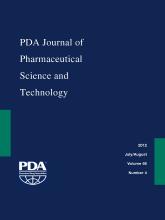Abstract
Notable progress has been made in methods that encourage the use of polymerase chain reaction (PCR) as a rapid and accurate tool in microbiological testing of pharmaceuticals. In this study, the detection of the four main specified microorganisms according to the pharmacopeial recommendations, Salmonella spp, Escherichia coli, Pseudomonas aeruginosa, and Staphylococcus aureus, was optimized in different pharmaceutical dosage forms and raw materials. Uniplex PCR was performed for the detection of each microorganism individually targeting the conserved region in each bacterial genome. Further optimizations were done to perform duplex and multiplex PCR assays considering relative concentrations of competitor primers used in the reaction. The uniplex PCR amplicons were successfully sequenced, confirming the conservation of used primers. Other validation parameters such as specificity, sensitivity, and robustness were examined closely. The method provides a high-throughput screening method to test different pharmaceutical preparations for specified microorganisms for the detection of microbiological contamination.
LAY ABSTRACT: Strict regulations govern the production of pharmaceutical products whether they are sterile or nonsterile. Certain official tests are carried out in microbiology testing laboratory in any pharmaceutical production facility to ensure the pharmaceuticals microbiological quality according to the standard pharmacopeial recommendations. Nonsterile products must be free of specified microorganisms that are used as a check for their quality. Topical preparations must be free of Pseudomonas aeruginosa and Staphylococcus aureus, and oral preparations must be free of Salmonella spp and Escherichia coli. Conventional microbiological methods are time-consuming, labor-intensive, and require long incubation times, resulting in delaying the release of the products. In this study, we tested and validated a polymerase chain reaction identification approach to detect indicator bacteria in pharmaceutical preparations. The method depends on amplification of certain conserved genes located in the four specified bacteria. The method is optimized to be carried out individually or collectively to detect all indicator bacteria in a single reaction in different forms of pharmaceutical products.
- © PDA, Inc. 2012
PDA members receive access to all articles published in the current year and previous volume year. Institutional subscribers received access to all content. Log in below to receive access to this article if you are either of these.
If you are neither or you are a PDA member trying to access an article outside of your membership license, then you must purchase access to this article (below). If you do not have a username or password for JPST, you will be required to create an account prior to purchasing.
Full issue PDFs are for PDA members only.
Note to pda.org users
The PDA and PDA bookstore websites (www.pda.org and www.pda.org/bookstore) are separate websites from the PDA JPST website. When you first join PDA, your initial UserID and Password are sent to HighWirePress to create your PDA JPST account. Subsequent UserrID and Password changes required at the PDA websites will not pass on to PDA JPST and vice versa. If you forget your PDA JPST UserID and/or Password, you can request help to retrieve UserID and reset Password below.






